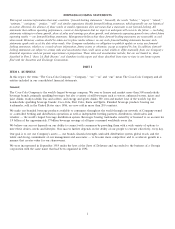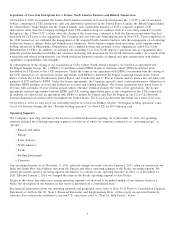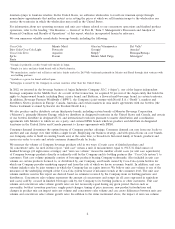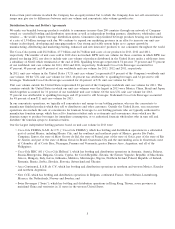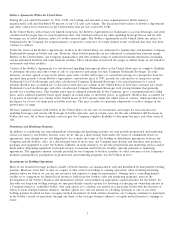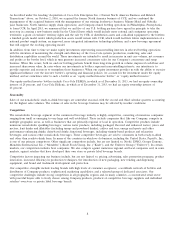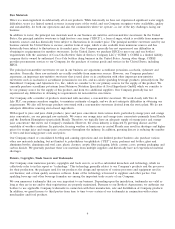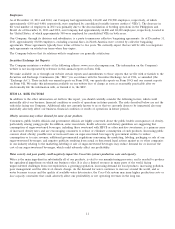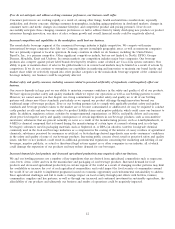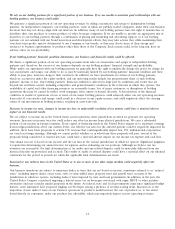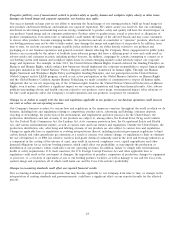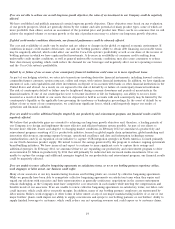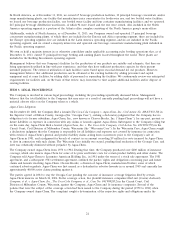Coca Cola 2013 Annual Report Download - page 13
Download and view the complete annual report
Please find page 13 of the 2013 Coca Cola annual report below. You can navigate through the pages in the report by either clicking on the pages listed below, or by using the keyword search tool below to find specific information within the annual report.Employees
As of December 31, 2013 and 2012, our Company had approximately 130,600 and 150,900 employees, respectively, of which
approximately 4,100 and 4,400, respectively, were employed by consolidated variable interest entities (‘‘VIEs’’). The decrease in
the total number of employees in 2013 was primarily due to the deconsolidation of bottling operations in the Philippines and
Brazil. As of December 31, 2013 and 2012, our Company had approximately 66,800 and 68,300 employees, respectively, located in
the United States, of which approximately 500 were employed by consolidated VIEs in both years.
Our Company, through its divisions and subsidiaries, is a party to numerous collective bargaining agreements. As of December 31,
2013, approximately 18,000 employees, excluding seasonal hires, in North America were covered by collective bargaining
agreements. These agreements typically have terms of three to five years. We currently expect that we will be able to renegotiate
such agreements on satisfactory terms when they expire.
The Company believes that its relations with its employees are generally satisfactory.
Securities Exchange Act Reports
The Company maintains a website at the following address: www.coca-colacompany.com. The information on the Company’s
website is not incorporated by reference in this annual report on Form 10-K.
We make available on or through our website certain reports and amendments to those reports that we file with or furnish to the
Securities and Exchange Commission (the ‘‘SEC’’) in accordance with the Securities Exchange Act of 1934, as amended (the
‘‘Exchange Act’’). These include our annual reports on Form 10-K, our quarterly reports on Form 10-Q and our current reports
on Form 8-K. We make this information available on our website free of charge as soon as reasonably practicable after we
electronically file the information with, or furnish it to, the SEC.
ITEM 1A. RISK FACTORS
In addition to the other information set forth in this report, you should carefully consider the following factors, which could
materially affect our business, financial condition or results of operations in future periods. The risks described below are not the
only risks facing our Company. Additional risks not currently known to us or that we currently deem to be immaterial also may
materially adversely affect our business, financial condition or results of operations in future periods.
Obesity concerns may reduce demand for some of our products.
Consumers, public health officials and government officials are highly concerned about the public health consequences of obesity,
particularly among young people. In addition, some researchers, health advocates and dietary guidelines are suggesting that
consumption of sugar-sweetened beverages, including those sweetened with HFCS or other nutritive sweeteners, is a primary cause
of increased obesity rates and are encouraging consumers to reduce or eliminate consumption of such products. Increasing public
concern about obesity; possible new or increased taxes on sugar-sweetened beverages by government entities to reduce
consumption or to raise revenue; additional governmental regulations concerning the marketing, labeling, packaging or sale of our
sugar-sweetened beverages; and negative publicity resulting from actual or threatened legal actions against us or other companies
in our industry relating to the marketing, labeling or sale of sugar-sweetened beverages may reduce demand for or increase the
cost of our sugar-sweetened beverages, which could adversely affect our profitability.
Water scarcity and poor quality could negatively impact the Coca-Cola system’s production costs and capacity.
Water is the main ingredient in substantially all of our products, is vital to our manufacturing processes, and is needed to produce
the agricultural ingredients on which our business relies. It is also a limited resource in many parts of the world, facing
unprecedented challenges from overexploitation, a growing population, increasing demand for food products, increasing pollution,
poor management and the effects of climate change. As the demand for water continues to increase around the world, and as
water becomes scarcer and the quality of available water deteriorates, the Coca-Cola system may incur higher production costs or
face capacity constraints that could adversely affect our profitability or net operating revenues in the long run.
11


